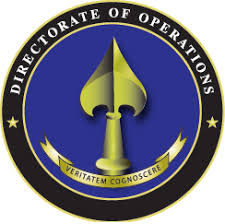Espionage, spying, or intelligence gathering is the act of obtaining secret or confidential information (intelligence). A person who commits espionage is called an espionage agent or spy. Any individual or spy ring, in the service of a government, company, criminal organization, or independent operation, can commit espionage. The practice is clandestine, as it is by definition unwelcome. In some circumstances, it may be a legal tool of law enforcement and in others, it may be illegal and punishable by law.

The Defense Intelligence Agency (DIA) is an intelligence agency and combat support agency of the United States Department of Defense, specializing in defense and military intelligence.

Human intelligence is intelligence gathered by means of interpersonal contact, as opposed to the more technical intelligence gathering disciplines such as signals intelligence (SIGINT), imagery intelligence (IMINT) and measurement and signature intelligence (MASINT).

Counterintelligence is an activity aimed at protecting an agency's intelligence program from an opposition's intelligence service. It includes gathering information and conducting activities to prevent espionage, sabotage, assassinations or other intelligence activities conducted by, for, or on behalf of foreign powers, organizations or persons.
Resistance to interrogation, RTI or R2I is a type of military training to British and other NATO soldiers to prepare them, after capture by the enemy, to resist interrogation techniques such as humiliation and torture.
In intelligence organizations, agent handling is the management of so-called agents, principal agents, and agent networks by intelligence officers typically known as case officers.

Tradecraft, within the intelligence community, refers to the techniques, methods and technologies used in modern espionage (spying) and generally, as part of the activity of intelligence assessment. This includes general topics or techniques, or the specific techniques of a nation or organization.

The Directorate of Operations (DO), less formally called the Clandestine Service, is a component of the US Central Intelligence Agency. It was known as the Directorate of Plans from 1951 to 1973; as the Directorate of Operations from 1973 to 2005; and as the National Clandestine Service (NCS) from 2005 to 2015.
The US Army Field Manual on Interrogation, sometimes known by the military nomenclature FM 34-52, is a 177-page manual describing to military interrogators how to conduct effective interrogations while conforming with US and international law. It has been replaced by FM 2-22.3 Human Intelligence Collector Operations.
Intelligence collection management is the process of managing and organizing the collection of intelligence from various sources. The collection department of an intelligence organization may attempt basic validation of what it collects, but is not supposed to analyze its significance. There is debate in U.S. intelligence community on the difference between validation and analysis, where the National Security Agency may try to interpret information when such interpretation is the job of another agency.
National intelligence programs, and, by extension, the overall defenses of nations, are vulnerable to attack. It is the role of intelligence cycle security to protect the process embodied in the intelligence cycle, and that which it defends. A number of disciplines go into protecting the intelligence cycle. One of the challenges is there are a wide range of potential threats, so threat assessment, if complete, is a complex task. Governments try to protect three things:
Clandestine human intelligence is intelligence collected from human sources using clandestine espionage methods. These sources consist of people working in a variety of roles within the intelligence community. Examples include the quintessential spy, who collects intelligence; couriers and related personnel, who handle an intelligence organization's (ideally) secure communications; and support personnel, such as access agents, who may arrange the contact between the potential spy and the case officer who recruits them. The recruiter and supervising agent may not necessarily be the same individual. Large espionage networks may be composed of multiple levels of spies, support personnel, and supervisors. Espionage networks are typically organized as a cell system, in which each clandestine operator knows only the people in his own cell, perhaps the external case officer, and an emergency method to contact higher levels if the case officer or cell leader is captured, but has no knowledge of people in other cells. This cellular organization is a form of compartmentalisation, which is an important tactic for controlling access to information, used in order to diminish the risk of discovery of the network or the release of sensitive information.
The Clandestine HUMINT page adheres to the functions within the discipline, including espionage and active counterintelligence.
Clandestine HUMINT asset recruiting refers to the recruitment of human agents, commonly known as spies, who work for a foreign government, or within a host country's government or other target of intelligence interest for the gathering of human intelligence. The work of detecting and "doubling" spies who betray their oaths to work on behalf of a foreign intelligence agency is an important part of counterintelligence.
The target-centric approach to intelligence is a method of intelligence analysis that Robert M. Clark introduced in his book "Intelligence Analysis: A Target-Centric Approach" in 2003 to offer an alternative methodology to the traditional intelligence cycle. Its goal is to redefine the intelligence process in such a way that all of the parts of the intelligence cycle come together as a network. It is a collaborative process where collectors, analysts and customers are integral, and information does not always flow linearly.
An intelligence collection plan (ICP) is the systematic process used by most modern armed forces and intelligence services to meet intelligence requirements through the tasking of all available resources to gather and provide pertinent information within a required time limit. Creating a collection plan is part of the intelligence cycle.
The reconnaissance mission within the United States Marine Corps is divided into two distinct but complementary aspects; Marine Division Recon and Force Reconnaissance.

Army Field Manual 2 22.3, or FM 2-22.3, Human Intelligence Collector Operations, was issued by the Department of the Army on September 6, 2006. The manual gives instructions on a range of issues, such as the structure, planning and management of human intelligence operations, the debriefing of soldiers, and the analysis of known relationships and map data. The largest and most newsworthy section of the document details procedures for the screening and interrogation of prisoners of war and unlawful combatants.
CyberHumint refers to the set of skills used by hackers, within Cyberspace, in order to obtain private information while attacking the human factor, using various psychological deceptions. CyberHumint includes the use of traditional human espionage methodologies, such as agent recruitment, information gathering through deception, traditionally known as Humint, combined with deception technologies known as Social engineering.
A human intelligence exploitation team is a tactical collection asset usually at the battalion or higher level that uses HUMINT techniques such as interrogations and source operations to collect information to fulfill intelligence requirements.





